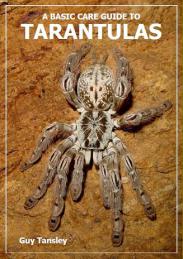
Cyriopagopus Simon, 1892 contains 9 described species but in recent years, many new and unidentified (possible)
Cyriopagopus spp. have become available. All are fossorial in nature requiring enough substrate
in their enclosures to allow them to dig their deep burrows (details on construction of a fossorial set-up can be found here). Most are highly
defensive and will readily assume the threat posture and some will even strike if provoked. Caution is advised when attempting to pair members of this genus as often males are misidentified resulting
in either death of the male or hybridisation between species. Given the right conditions, captive breeding is fairly straight forward so captive bred spiderlings should be available.
Common species in captivity:
C. albostriatus (Simon, 1886) -
Myanmar, Thailand, Cambodia
Easily distinguished from others in the genus by characteristic white stripes to the patella and tibia of all the legs. There can be some colour variation and some specimens can be quite dark.
Typical fossorial set-up is ideal for this medium sized deep burrower.
C. lividus Smith, 1996 -
Myanmar
A typical Asian species, H.
lividum is very aggressive and will readily bite if threatened. With it's striking blue
coloration (especially after a moult), it's a must for any serious collection but due to its burrowing habits, rarely seen. A copious web
spinner, H. lividum constructs elaborate tube webs. Breeding is an aggressive affair with the male showing no fear at all towards the female. Deep substrate is
recommended for this burrowing species. Medium sized tank with moist compost. Up to 13 cm leg span.
C. minax (Thorell, 1897) -
Myanmar, Thailand
Highly defensive and, with all Asian species, not recommended for the beginner. Also known as the 'edible' tarantula as local people of Thailand consider them a delicacy. Breeding is aggressive but
the male usually comes to no harm. Another copious web spinner especially around its elaborate burrow entrance that can take on a funnel-like shape, incorporating substrate and surrounding material.
Deep substrate is recommended for this burrowing species. Medium sized tank with moist compost.
C. schmidti von Wirth, 1991 -
Vietnam
One of the largest of the group and with recent importations, it is becoming more common in the hobby. There is some confusion of the description
of H. schmidti and the future may see this one being moved to another genus. Two colour forms are said to exist in captivity - the dark 'chocolate' form and the
lighter 'gold' form. Housing and behaviour is similar to others in the group (deep substrate to allow for burrowing etc).

